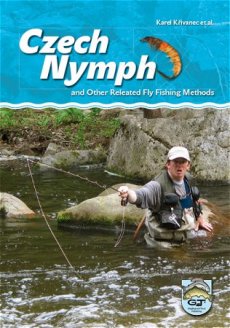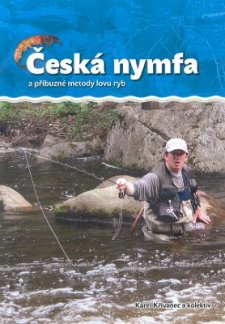Review of the first book dedicated to Czech nymphing.
Reviewed by Bob Petti, www.globalflyfisher.com
I was tying at a show in Roscoe, NY this past Spring when a gentleman approached my table to ask about tying Czech nymphs, referring the article I wrote a couple years ago . Unfortunately I did not have any materials for those flies on that day so I was unable to show him the methods in person, but we did chat for awhile regarding the flies and the tackle and techniques for fishing them. As I am certainly no world authority on the topic, I wish I had a copy of this book to show him so he could learn from the masters.
In Czech Nymph, Karel Krivanec has given anglers around the world the opportunity to learn about the history and techniques of this interesting fly fishing method from the people who practice it on a daily basis. As you might guess, the origins of this angling technique are rooted in the fishing competitions that are so common in Europe. Reading through the history chapter, I was struck once again at the ingenuity shown by fly anglers and tyers, a trait that certainly crosses all borders. In telling of some of the very first Czech nymphs, Krivanec writes:
At that time [ed: 1986] Slavoj was tying the bodies of his patterns with plastic foam, which he got from a sponge used for cleaning cars. Its disadvantage was its short life span. Another of his proven patterns was the "Carrot", which he brought from the Orava river region in Slovakia and for which he used a beige chameleon substitute and strips from a red raincoat. All was ribbed with horsehair.
I believe in the above passage, "chameleon" refers to a chamois which is used to absorb water and dry off freshly washed vehicles. I don't think he was using strips of little tan lizards to tie up his nymphs. I should say here the book's original language is Czech, so the English version occasionally has some challenges with the translation.
The book is split about half and half between fishing and tying discussion. In the fishing section, it becomes clear that rods and reels are less important than the terminal tackle, even though plenty of European rod makers offer rods specifically designed for Czech nymphing. The author makes is clear that since traditional fly casting is not a concern of the nympher, the important aspects of the rod and reel are that they are strong enough to set the hook and land the fish, are balanced and comfortable to fish with, and long enough to reach the spots the angler needs to reach. Buying new rods are fun, of course, but my guess is someone interested in trying Czech nymphing probably has one or two rods already in his possession that will work just fine.
Far more important in Czech nymphing is the design of the leader, and Krivanec draws on the expertise of several successful anglers to describe their typical leader setup. This is one aspect where the American angler will be well advised to pay attention, since from a distance the technique on the river looks like "high stick" nymphing and it would be easy to think that the same heavy butt tapered leader is used. Not so. The leaders are typically much thinner than American anglers since "turn over" is not a concern. The aim is to get the flies to drop through heavy current as easily and quickly as possible. A heavy butt leader would tend to bouy the flies, a sure no-no in Czech nymphing.
Krivanec then goes on to discuss the water types and techniques used to fish Czech nymphs. The support diagrams and photos are excellent and any competent angler should have no problem learning the methods and applying them to their home waters.
Almost all Czech nymphs share the same construction techniques - a curved hook, plenty of weight, a dubbed body, a shellback, and some ribbing - but the variety of nymphs is almost endless. Some sparkle with flash and bright colors, and some are very subdued using only natural materials. As you might guess, the tying portion of the book is less oriented toward fancy vise maneuvers and more toward fly patterns.
New to the American angler will be the hooks that have various weights molded onto the shank. Not so much the micro jig, which is well known, but rather the hooks that have different weights molded onto the shank itself. One hook has a teardropped shape on the front portion of the hook which replaces the thorax section of a normal nymph. My friend Pavel sent me some of these hooks and a few flies tied on them, and I'm anxious to try them out on my own waters someday.
For anyone who wants to learn more about Czech nymphing, I can certainly recommend Karel Krivanec's "Czech Nymph". It will answer all your questions, even if your question is "where can I get some of those cool hooks?!?".














